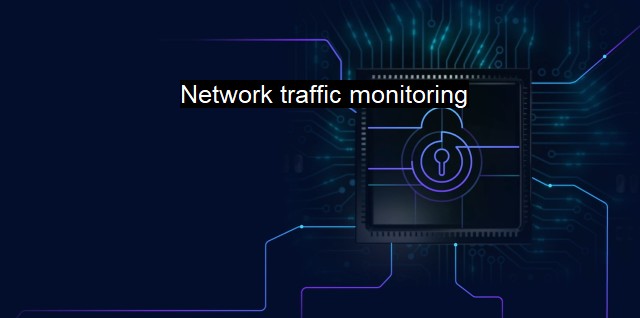What is Network traffic monitoring?
Why Network Traffic Monitoring is Crucial for Cybersecurity: Analyzing and Managing Data to Combat Cyber Attacks
Network traffic monitoring, in the context of cybersecurity and antivirus systems, is a critical aspect integral to the proper functioning and safety of a digital environment. It is a proactive measure within a cybersecurity framework concerned with the constant surveillance, tracking, and analysis of all data transmitted over a network.A network, in this regard, can be any digital environment interconnected through a media, irrespective of scale. It could range from a few devices connected through a local platform or wifi array to a larger setup like a wide-area nexus (WAN) spread across various operational units. Especially in larger and more complex networks, monitoring the traffic becomes pivotal in mitigating possible threats, breaches, and network failures that may compromise the data or the integrity of the systems connected.
Network traffic monitoring is essentially about collecting the metadata associated with network use. It could cover several parameters like network speed, packet loss, latency, bandwidth used, protocols utilized, and details regarding host connections. Consequently, by evaluating these factors, one can deduce the general morphology of network activity and mark potential issues that may arise in the future.
Cybersecurity heavily relies on network traffic monitoring as it paves the way to identifying threats, be it real-time or in retrospect. Whenever there is a connection made by any network device to an external or internal server, data packets are transmitted. These packets can be harmless but in some instances, can also be dangerous malware or viruses. Monitoring enables one to intercept these data packets and perform a thorough analysis to detect any anomalies.
Analyzing traffic patterns can alert an organization or an individual to harmful activities before any severe damage is done. Unusual traffic or sudden surges in network activities may indicate a potential security attack, perhaps initiate by mysterious sources aiming to gain unauthorized access or manipulate the data or applications connected. Viruses, spyware, ransomware, or other malware entering a network can be tracked, and protective measures can be deployed to alleviate any harmful impact.
The influx and diversity of network traffic have seen a significant rise with the advent and integration of the Internet of Things (IoT) devices into network systems. Be it a large business enterprise or a small residential setup, increased device connectivity has contributed to making a network landscape more vulnerable to cyberattacks. A persevering surveillance ensures that threats don't go unnoticed and are neutralized on arrival.
It's also important to mention that traffic monitoring allows for performance optimization by controlling bandwidth consumption, identifying bottlenecks, and managing Quality of Service (QoS). It makes troubleshooting easier and quicker by uncovering the root cause of network slowdowns or failures. this enhanced visibility ensures a more robust and resilient posture against potential threats.
In combination with antivirus systems, network traffic monitoring becomes a mighty tool – where monitoring gives direction; antivirus serves as a line of action. Modern sophisticated antivirus solutions, apart from scanning system files, are integrated with advanced network traffic screening methods capable of identifying and resisting known and unknown threats.
Antivirus systems vigilantly investigate the incoming and outgoing traffic, intercept unknown packets or files, scrutinize for potential threats, and accordingly take preventive measures. Builtin firewall screenings could further prevent access from suspicious sources thus elevating the level of protection.
Integration of machine learning and AI on antivirus platforms improved the efficiency of traffic monitoring remarkably. While machine learning models continually evolve with ever-changing threat landscapes, AI-based behavior blockers competent of identifying abnormal behavioral patterns further reinforce the security array.
Network traffic monitoring, backed by a robust antivirus system, promotes a secure operational environment preventing potential cyber threats. Besides securing the network, it also assists in maintaining the overall network performance. Living in data-driven times, the use of network monitoring for cybersecurity can’t be more critical, looking at the rising trepidation towards data integrity and privacy breaches. It undoubtedly is a valuable undertaking for any individual or enterprise aiming for a secure and robust network system.

Network traffic monitoring FAQs
What is network traffic monitoring?
Network traffic monitoring is the process of analyzing network data packets to gain insights into the flow of network traffic. This helps in identifying potential security threats and taking appropriate measures to mitigate them.Why is network traffic monitoring important for cybersecurity?
Network traffic monitoring plays a crucial role in detecting security breaches and attacks. It helps in identifying unusual network behavior, analyzing patterns, and detecting anomalies, which are indicators of malicious activities.What are the benefits of network traffic monitoring to antivirus software?
Network traffic monitoring helps antivirus software to detect and prevent malware attacks by analyzing network traffic data packets. It helps in identifying suspicious data packets and filtering out malicious traffic. This enhances the accuracy and effectiveness of antivirus software.What are the different types of network traffic monitoring techniques?
There are various network traffic monitoring techniques such as packet sniffing, flow monitoring, deep packet inspection, and network intrusion detection. Each technique has its own advantages and limitations, and choosing the right technique depends on the specific use case and requirements.| | A | | | B | | | C | | | D | | | E | | | F | | | G | | | H | | | I | | | J | | | K | | | L | | | M | |
| | N | | | O | | | P | | | Q | | | R | | | S | | | T | | | U | | | V | | | W | | | X | | | Y | | | Z | |
| | 1 | | | 2 | | | 3 | | | 4 | | | 7 | | | 8 | | |||||||